Botanical Illustration: Compound and Simple leaves
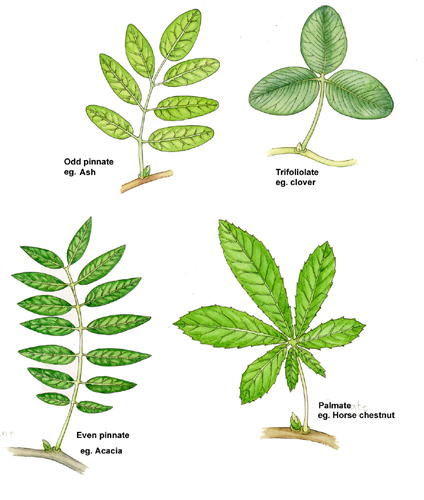
I’ve recently completed some botanical illustrations and diagrams of leaves. They’re for for The 21st Century Herbal by Michael Balick. Several illustrations demonstrating different botanical terms for leaf shape were required.
Reasons why botanical terminology helps
I think knowing what variety exists in nature helps you to understand what you’re drawing. So I thought I’d share some botanical terminology with you. The terms discussed are in bold text; the examples are all illustrations I’ve done over the years. If you find any mistakes feel free to tell me, I’m no botanist, just a keen and interested amateur.
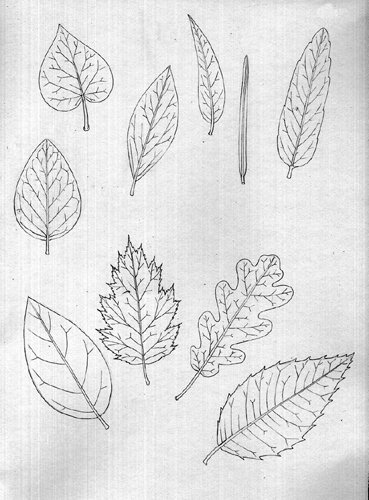
Leaves and their anatomy: Things to consider
When illustrating plants you need to consider: the leaf structure, its shape, its margins, its venation, and the position of the leaves in relation to one another and the stem.
This would result in a frighteningly long blog. For today I’ll just discuss compound vs simple leaves, and some basic shapes of simple leaves.
Compound and Simple leaves: Which is which?
First, establish whether your leaf is simple, (in one piece) or compound (subdivided into smaller leaves). Each of these smaller divisions is known as a leaflet. A good trick here is to look for a bud. Buds only occur at the junction of a leaf stem (petiole) and the main stem. They never appear at the base of a leaflet’s stem (called a rachis). This is shown in my illustration of different forms of compound leaves below.
Compound leaves

Compound leaves and simple leaves come in a wide variety of shapes. For example; a chestnut leaf, spreading its hand-like shape, is a compound leaf. It is made of 5 to 7 leaflets, all anchored centrally. The little leaflets are arranged a little like the fingers of a hand, hence the term palmate.

A leaf from the clover family (represented here by the bird’s foot trefoil) consists of three little leaflets, again, attached to one central point. The term translates the English “three-leaved” into latin terminology: trifoliolate.
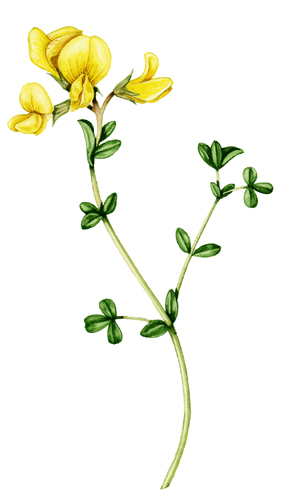
Sometimes, what appears to be a branch or sprig of leaves are, in fact, one leaf composed of many leaflets. This is true of the ash.
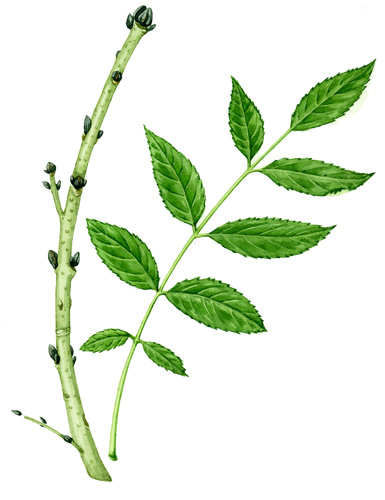
Look for the bud at the junction of the leaves if you’re confused
Confused? Use the trick of searching for the bud. It’s at the junction of the sprig with the stem, you never see a little bud at the base of an individual leaflet. This array is called pinnate, and in this case it’s an odd pinnate example since there’s one leaflet at the tip without a pair. You can also get even pinnate leaves (like the mimosa) where every leaflet has a pair, including at the tip of the rachis. Just to make things even trickier, if each leaflet is divided again (stay with me, and picture an acacia, if you can) this is called doubly compound, or bipinnate.
Simple leaves
You’ve established your leaf is not compound. If there is a bud to be seen, it’s at the base of the leaf stem. Your leaf is simple. But your life is not; because all leaves are by no means alike. There’s a vast amount of shape variation amongst leaf shape (and a bit of variation between botanists who sometimes use different terms for these shapes. In this blog, my references are Botany: A functional Approach by W. Muller, and Botany: A Textbook for Colleges by Hill, Popp, and Grove.)
The easiest shape to identify is Linear, or line-like. Lavender and rosemary are examples.

A cordate leaf is somewhat heart-shaped; mulberry and lime are examples.
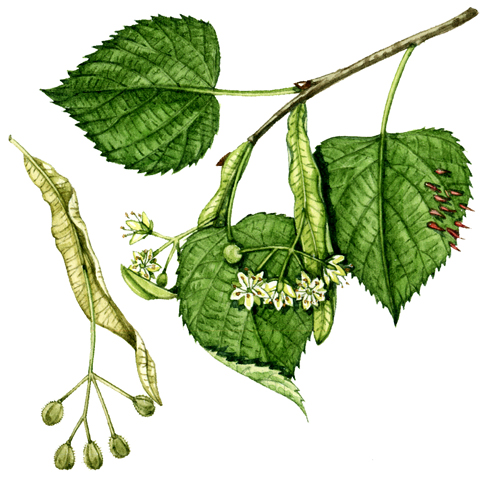
Ovate leaves are egg-shaped, with their base a little wider than their middle and their tip a little thinner than the middle; as with the beech leaf.
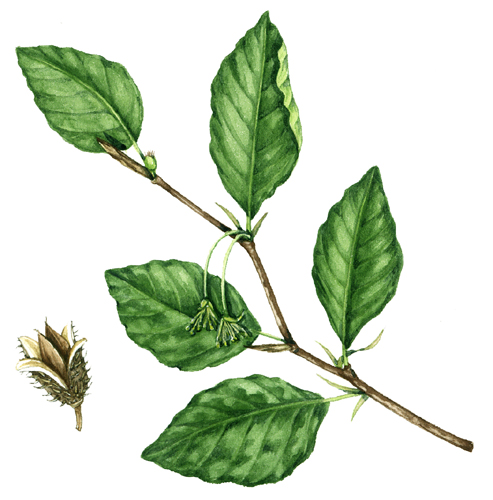
A lanceolate leaf is a very narrow ovate (egg-shaped) leaf; it tends to be at least 6x longer than it is wide. Willow leaves are lanceolate.

Elliptical leaves are widest in their middle and taper evenly on either side of this. Mint, cherry, and sage leaves are examples.

Oblong leaves are broad and un-tapered. An example is the olive, and rhododendron.
Simple leaves: An overview
Here’s the overview of simple leaf shapes in one image:
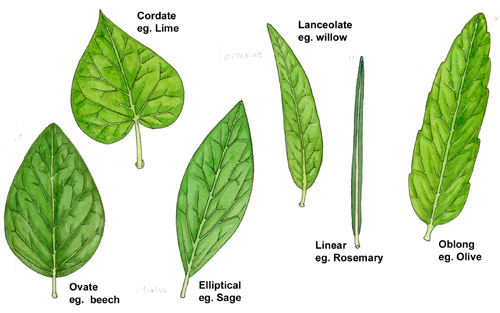
There are many other leaf shapes, such as orbicular, rotundifoliate or peltate (all terms relate to leaves which are round, like a nasturtium) and sagittate (like an arrow) to name but two. (For further discussion and examples, please follow this link from the University of Maryland.)
From the remit I had in doing the illustrations for The Rodale 21st Century Herbal, this is most of what I examined. I hope some of it helps people as much as it has helped me.


This post was fun to read and so incredibly helpful! Thank you so much!
Hi Britt, Im so glad it was helpful, and enjoyable. Thankyou so much for taking the time to leave a comment!
Thank you so much for this, it’s so generous of you to share your work. These illustrations have helped me so much.
Your work is beautiful.
Hiya Debra
Absolutely my pleasure. Took me AGES to get my round round all of these terms!
X
Thx for the reference
My pleasure!
A very informative post and lovely paintings! However, I am still a little confused. I am studying a juvenile ivy leaf. It is five lobed and palmate but a I am not sure if it is simple or compound. Help! 🙂
Hi Shirley
I totally understand the confusion. A compound leaf has to be composed of different leaflets, which look like individual leaves. Ivy leaves are simple (i.e. lobed or unlobed but not separated into leaflets) because they aren’t separated into leaflets. Hope this helps? Thanks for asking. x
Beautiful illustrations and extremely well explained. Thank you
Thank you, Norman!
I am interested in plant identification. This post is very easy to understand. Thank you!
I’m so pleased to be able to help, that’s great to hear. thankyou.
I thank you for the good information about the leaves I am really looking for good work 👏 🙌 👍 👌 😊
Hope the information helps as you continue with your work.
Excellent 👍 information ☺️
This helps me a lot
I am SO glad to hear that! Thanks for leaving a comment
Knowing botanical terminology has been incredibly helpful for me in my gardening and landscaping endeavors. Not only does it give me the language to describe the plants and flowers I’m working with, but it also helps me understand the different characteristics of certain plants and flowers, so I can make the best decisions for my garden design. Botanical terminology has given me the ability to speak more confidently and knowledgeably with other gardeners and landscapers and has even allowed me to be more creative when choosing the right plants for my garden. It has also been a great resource to consult when I’m looking for guidance on how to properly care for a certain type of flower or tree.
I totally understand what you mean. Its like a bit of knowledge opens so many doors, both within the botanical community and within our own brains. And even things that initially seem so confusing (I struggle with the anatomy of different ovary tissues to fruit development) can, once ironed out, feel so straightforward. Im so glad that youve found botanical knowledge helps you in your work, sounds like it dovetails perfectly with the plant choice and landscaping work you do. Lovely to hear this, and I agree totally. Knowledge about this stuff is wonderful, and well worth exploring. Every time I have a new plant to draw, it means more to me once Ive reas up about it in the botanically descriptive literature. And to do that? You need a bit of botany knowledge. Thanks for the comment.
This post about botanical illustration is absolutely fascinating! I’ve always been captivated by the intricate details of leaves and how they contribute to the overall beauty of plants. Compound and simple leaves have such distinct characteristics, and it’s incredible how artists can capture their unique forms through botanical illustrations. The way different shapes, textures, and veining patterns are depicted in these illustrations truly brings out the essence of each leaf type. It’s both educational and aesthetically pleasing. I would love to learn more about the techniques and tools used by botanical illustrators to create such stunning representations. Do you have any recommendations for resources or tutorials to explore this art form further? Thanks for sharing this inspiring post!
Hi West
Glad you like the blog. Yes, I have a whole section of blogs on step by steps for botanical illustration: https://lizzieharper.co.uk/category/botanical-illustration-step-by-step/. Hope these might be of use.
How do botanical illustrators ensure scientific accuracy while also infusing artistic expression into their representations of compound and simple leaves?